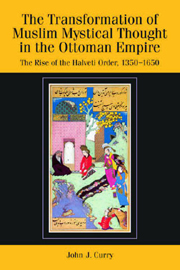 The Transformation of Muslim Mystical Thought in the Ottoman Empire
The Transformation of Muslim Mystical Thought in the Ottoman Empire Book contents
- Frontmatter
- Contents
- List of Maps and Figures
- Abbreviations for Frequently Cited Works in the Text
- Acknowledgments
- Note on Transliteration
- Map 1
- Map 2
- INTRODUCTION: ON THE STUDY OF OTTOMAN MYSTICAL TRADITIONS
- PART I THE RISE AND SPREAD OF THE HALVETİ ORDER FROM ITS ORIGINS THROUGH THE ELEVENTH/SEVENTEENTH CENTURY
- PART II THE EVOLUTION OF A HALVETİ SUB-BRANCH: THE LIFE AND CAREER OF ŞAcBÂN-I VELİ AND HIS FOLLOWERS IN THE KASTAMONU REGION
- INTRODUCTION
- 3 ECHOES OF A DISTANT PAST: ŞAcBÂN-I VELİ'S EARLY LIFE AND CONVERSION TO SUFISM
- 4 GENESIS OF A SUB-BRANCH: ŞAcBÂN-I VELİ'S STRUGGLES IN KASTAMONU
- 5 AN UNEVEN LEGACY: THE SUCCESSION TO ŞAcBÂN-I VELİ TO THE END OF THE TENTH/SIXTEENTH CENTURY
- PART III DEFENDING THE CULT OF SAINTS IN ELEVENTH/SEVENTEENTH-CENTURY KASTAMONU: TRANSFORMING THE ŞAcBÂNİYE ORDER UNDER cÖMER EL-FUɔÂDÎ
- CONCLUSION: WHAT CAN THE ŞAcBÂNİYE TEACH US ABOUT TRANSITIONS IN THE EARLY MODERN PERIOD OF WORLD HISTORY?
- Appendix I
- Appendix II
- Works Cited and Further Reading
- Index of Persons
- Index of Places
- Index of Subjects
4 - GENESIS OF A SUB-BRANCH: ŞAcBÂN-I VELİ'S STRUGGLES IN KASTAMONU
from PART II - THE EVOLUTION OF A HALVETİ SUB-BRANCH: THE LIFE AND CAREER OF ŞAcBÂN-I VELİ AND HIS FOLLOWERS IN THE KASTAMONU REGION
Published online by Cambridge University Press: 12 September 2012
- Frontmatter
- Contents
- List of Maps and Figures
- Abbreviations for Frequently Cited Works in the Text
- Acknowledgments
- Note on Transliteration
- Map 1
- Map 2
- INTRODUCTION: ON THE STUDY OF OTTOMAN MYSTICAL TRADITIONS
- PART I THE RISE AND SPREAD OF THE HALVETİ ORDER FROM ITS ORIGINS THROUGH THE ELEVENTH/SEVENTEENTH CENTURY
- PART II THE EVOLUTION OF A HALVETİ SUB-BRANCH: THE LIFE AND CAREER OF ŞAcBÂN-I VELİ AND HIS FOLLOWERS IN THE KASTAMONU REGION
- INTRODUCTION
- 3 ECHOES OF A DISTANT PAST: ŞAcBÂN-I VELİ'S EARLY LIFE AND CONVERSION TO SUFISM
- 4 GENESIS OF A SUB-BRANCH: ŞAcBÂN-I VELİ'S STRUGGLES IN KASTAMONU
- 5 AN UNEVEN LEGACY: THE SUCCESSION TO ŞAcBÂN-I VELİ TO THE END OF THE TENTH/SIXTEENTH CENTURY
- PART III DEFENDING THE CULT OF SAINTS IN ELEVENTH/SEVENTEENTH-CENTURY KASTAMONU: TRANSFORMING THE ŞAcBÂNİYE ORDER UNDER cÖMER EL-FUɔÂDÎ
- CONCLUSION: WHAT CAN THE ŞAcBÂNİYE TEACH US ABOUT TRANSITIONS IN THE EARLY MODERN PERIOD OF WORLD HISTORY?
- Appendix I
- Appendix II
- Works Cited and Further Reading
- Index of Persons
- Index of Places
- Index of Subjects
Summary
We cannot determine the exact date that Şacbân-ı Veli arrived in Kastamonu as a designated successor of Hayreddîn Tokâdî. His hagiography is silent about the specific circumstances that led to his departure from the region of Bolu; we do not even know if Tokâdî sent him or if he migrated there after his shaykh's death. The hagiography states only that he remained in service to the Bolu-based branch of the order for twelve years. However, we do know that he spent the majority of his life, probably exceeding four decades, as a resident of Kastamonu after leaving Bolu. When compared with our knowledge about Şacbân's early life, we receive far more information about his activities in Kastamonu, and the personality of this saint-to-be comes into much greater focus.
What is most striking about Şacbân's life, however, is not the success he experienced in building a sub-branch of the order in Kastamonu. After all, the hagiographer cÖmer el-Fuɔâdî would not have written such a substantial work about him had he failed in that task. What is most striking about Fuɔâdî's work is the degree to which Şacbân-ı Veli appears in these narratives as a saint capable of both personal and public failings, both in his own eyes and that of his community. While the very term “hagiography” implies that one will receive a laudatory, or even triumphant account of its subject's life, the reality of Şacbân-ı Veli's life and career did not always lend itself to this type of presentation.
- Type
- Chapter
- Information
- The Transformation of Muslim Mystical Thought in the Ottoman EmpireThe Rise of the Halveti Order, 1350–1650, pp. 108 - 155Publisher: Edinburgh University PressPrint publication year: 2010
